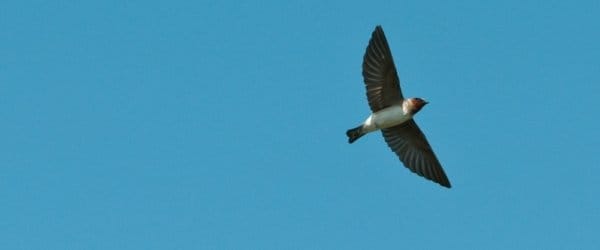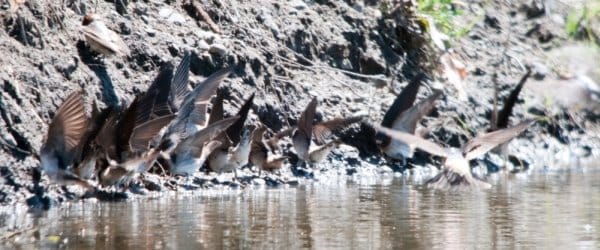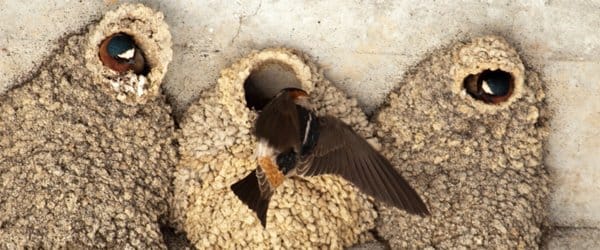Cliff Swallows (Petrochelidon pyrrhonota) nest in large colonies that may contain as many as 3,500 active gourd-shaped mud nests.
They are currently heading south on their yearly migration to South America where they will winter, and during this migration, they can often be seen in large flocks with other swallows numbering in the hundreds or even thousands.
This is a small flight of Cliff Swallows that were probably recent arrivals to a nesting site one beautiful spring day back in March (click on photos for full sized images).
So that you can get the feeling of having these birds swarm around you and hear their calls, I have included a video of this flock from the same location at Singer Creek in Chico, California.
httpv://youtu.be/JOZh_hZ_fCY
Once the birds begin visiting colony sites, they begin to pair up, coinciding with establishment of nest ownership or beginning of nest building. Once the location is selected, the nest building or refurbishing begins with the gathering of mud from a nearby stream, river or lake.
Birds gather mud in large synchronized groups, usually within a half mile of the colony, and bring it back in the form of mud pellets like the one seen in the beak of the bird in the center right below.
These excursions may continue for quite some time as groups come and go. You see, the average nest contains 900 to 1,200 individual mud pellets1.
The interesting thing to me, as I watched the Cliff Swallows gathering mud pellets, was the way they held their wings up, fluttering them as they dug in the mud.
I thought they were holding their wings up to keep them out of the mud, but no. This behavior is to prevent being attacked by males seeking extra pair copulations (EPC). I wrote an entire post on extra pair copulations among Cliff Swallows here. It’s an extraordinary behavior that is practiced by several species of birds.
Notice how their wings remain in the upward position at all times while gathering the mud. I saw no copulation attempts during the filming of this video 😉
httpv://youtu.be/s3UiB__qkPc
It may take over a week to build new nests but the time frame is highly variable depending on a number of factors, most importantly, the weather. It also depends on whether it is a new nest or an old nest that is being refurbished, and how many walls are shared with adjacent nests.
The mud pellet nests are placed on vertical cliff faces, entrances to caves, under eaves of buildings, under bridges, in highway culverts, and under overhangs on dams.
Cliff Swallows use buildings of all types, including sheds and barns, residences, and office buildings. Nests are also placed on bridges of all types, including ones over busily traveled roads, placed at the 90° juncture of a vertical wall and a horizontal overhang.
This colony is located in an unused cement building at Turtle Bay in Redding, California. You can see the triangular, white forehead patch of several swallows at the entrances of occupied nests.
httpv://youtu.be/mjcUhRehtGs
Once the gourd-shaped nest is nearly complete, the couple adds dry grass as the nest lining which is found at nearby banks and pastures but may also be stolen from unattended nests in the colony.
I hope you enjoyed some of the idiosyncrasies and behaviors of the Cliff Swallow that I have observed. Now you know what the fluttering, uplifted wings are all about when you happen to see them gathering mud next spring.
References: 1 Birds of North America Online





















What a great post! Cool pics and fascinating info.
Great photos and videos! We have a weekend getaway at a lake in South Carolina and there is a bridge we always go under when boating where there is a colony of swallow nests. A few months ago we stopped under the bridge so I could take some shots of all the activity that was going on. They were feeding their young at the time. The nests looked exactly like the ones you’ve shown here. They lined practically the entire length of the bridge. Thanks for all the information!
Amazing bit of information and great shots too!
I would like to know the best way to discourage these birds from building their nests in the eves of my house. They collect their mud pellets aboutside my backdoor and most of them go to the neighbor’s house to build, but occasionally they attempt to use my house. We live in Silverlake WA and they have been flying around here for about 3 weeks now.
@Angela the only way I know is to put screen or hardware cloth across your eves so they can’t get to the wood to start building nests there. They are a native species and once they have nests up and start laying eggs they are protected by the Migratory Bird Treaty Act and it is illegal to disrupt them.
I was observing the same behavior recently, but I have one additional musing. If the extra pair copulations are truly undesirable, why are all their tails raised when collecting mud, making the cloaca so accessible?